A house is only as strong as its foundation, right? Is that too trite or colloquial? Whatever, I like the analogy.
Your balance in the water is your foundation to a good stroke. Without it, forget what your arms are doing and kiss speed goodbye.
I call good balance in the water good body position, or being as horizontal as possible and as high in the water as possible. It all comes down to hydrodynamics, the water version of aerodynamics. Like punching the smallest hole through the wind on the bike, you want to punch the smallest hole through the water with your body. Having your legs drag or your butt hang low is like adding a parachute to the end of your bike.
Drag is your #1 enemy!!!
So to develop good body position in the water, here are some drills that I used and still use to find my place in the water. Now get ready to kick! But
NO FINS! I like fins. They are good for certain applications, but when trying to find body position, it is cheating, and you are only cheating yourself by using them. The name of the game here is to float horizontally without using any aids (pull buoys, kickboards, fins).
If any of you have used TI (Total Immersion), then these will be very familiar. I guess these drills are so good that they are widely used by TI and by swim coaches. These were first shown to me by my old coach, and then I saw them again when I watched the TI DVD. Trust me, they work.
#1) Floating.
Lay onto your back in the water and try to float without sinking. Don't kick, just float. Try to get yourself as flat as possible, like laying on a flat board:
 |
| 4 years of art school got me this drawing.... |
Now experiment with tucking your pelvis in (
like you are doing a stomach crunch), and your chin to your chest:
 |
| Even with a strange contorted spine, you are still horiztonal. |
Your legs will eventually drop (first @ the knees), but maintain this float for as long as possible. The pelvis tucking and chin tucking will be used for later drills, but it is what keeps your legs up and your chest up.
This is the position you want. It feels like you are resting your center of gravity more on your pelvis and back, right? Anchor points in a way?
Experiment with arching your stomach up and see what happens:
 |
| No good, right? |
How much faster did you sink with an arched back? Did your legs drop immediately?
Which position worked better for you?
#2) Kicking on your back, arms @ side. Pelvis pointing straight up.
This is the most basic kicking drill. Like you were floating still, you want to tuck your pelvis in, tuck your chin, and
kick from your hips. DON'T bend those legs @ the knee!!! Keep your feet flexible. You should feel a good burn in your upper thighs and hips. Remember to keep that pelvis tucked!
#2A) Instead of arms @ side, have either one arm streamlined above your head, or have both arms streamlined above your head.
#3) Kicking on your back, arms @ side. Pelvis and body rotated 30-45 degrees. Head looking straight up.
This is just like drill #2, except your whole body is rotated 30-45 degrees. This will teach you to find a balancing point on the side of your hip and in the shoulder area. Remember to kick from the hips. Its a bit harder in this position and it is easier to break @ the knees. Don't try to lift your head! Keep it tucked to your shoulder. Lifting your head will make your hips drop.
#3A) Instead of arms @ side, have your below the water arm extended above your head. You will rest your head on this arm while keeping your chin tucked.
#4) Kicking on your stomach, arms @ side. Looking straight down. Press your chest.
Flip over and stick your face in the water. Keep your arms at your side and press your chest into the water. Over-exaggerate this position. You want to feel like you are swimming "downhill". Pressing your chest will pop your hips to the surface, which is good! Lift up your head to breath. Lifting your head will make you sink, so give yourself a few seconds to regain your balance and pressed chest position. Take some rest after this one as it makes you hold your breath longer.
Remember to kick from the hips!!!!
 |
| Press that chest!!! |
And now for rotation, the 2nd part to balance.
So the above four drills with variations are for locking in a stable balance. With swimming, you aren't just laying flat on your stomach and swinging your arms with some kicking. You are constantly rotating your body. You NEVER want to be in a flat position. You always want to be rocking your body side to side. Think of it this way. You sit down in a rowboat, but you have no oars. You need to move to get the boat moving forward. How would you do this?
You rock the boat! Amazing how it suddenly starts to move forward? Same is true with your body in the water.
But what do you use to rotate your body? Well, the whole body is obvious, but there is one part of your body that has more say than other parts. Since you are anchoring yourself
with your hips, you want to rotate that anchor.
ALL of your rotation power should come from the hips. Your body will want to use the shoulders (because it is easiest), but that is inefficient. Why? Because that is like trying to spin a potted plant by its leaves. The best way to turn the potted plant is by its base, or its pot. Your hips are the pot and your shoulders are the leaves.
One final thing, think of a 10 foot pole going straight through your body. This pole is what you are rotating along. Keep your body rigid (but not tense) when you rotate. You don't want to fishtail or go limp while rotating.
Here are some rotation drills that build upon the static balance drills:
#5) Hip rotation, arms @ side, facing up.
This drill will involve drills
#2 &
#3 list above. Instead of staying in one position (either straight up, or angled to one side) you will rotate
using your hips from your left side to the middle to the right side in one fluid motion, pausing for a few kicks on the side. Concentrate on using those hips. I would do three kicks on my left side, then rotate to the right side, do three kicks, then repeat. Try to gain that sensation of rotating from the hips. You could do a variation and quickly "snap" from one side to the next. This "snap" is something you will want to incorporate into your stroke.
#6) 90 Degree rotation
This is when the drills start getting hard. I even struggle with this one, but it helps. Trust me!
Start out by doing drill
#3A listed above. Now rotate 90 degrees (
using your hips to drive the rotation) until you are now 30-45 degrees facing the bottom of the wall of the pool (not completely face down). Now rotate back to starting position. The trick with this drill is to NOT lift your head! As soon as you lift your head your hips will sink and you will swallow a bunch of water or it will go up your nose. Did I mention this drill is a bit more difficult? To make sure you don't lift your head, make that rotate from facing down to facing up
quick, especially by
driving those hips! Stretching your body out and being as streamlined as possible helps. Remember there is a pole going straight through you and you are rotating along that pole.
#7) Face down rotation
This drill is the same as
#5 listed above, except you are facing down. Remember, arms at your side! This is an uber hard drill, but if you can master this, you got yourself some incredible body position, balance, and rotation. I call this one the graduation drill. Rotate back to facing up every three rotations to breath.
#8) 90 Degree Rotation, arms @ side
This is an easier version of the #7 drill because it is the same drill as
#6, except your arms are @ your side. This is also an uber hard drill. Remember to rotate
from the hips!
Now if you are having a hard time discovering that "sensation" of what proper hip rotation feels like, I would suggest one drill and one pool toy if all else fails.
#9) Kicking with kickboard between the legs
Swim normally as if you are swimming with a pull buoy. Except swap out the pull buoy for a kickboard. Make sure the kickboard has more board in the water than above the water so it acts like a deeper rudder. Work those hips, rocking them side to side making sure you feel the kickboard's resistance against the water. Now take away the kickboard. Does it feel suddenly easier to rotate through the water? THAT is what proper hip rotation should feel like.
If this doesn't work, I would suggest the
Finis Hydro Hip:
 |
| If this doesn't do the trick, then you must be over thinking it! haha! |
HERE is my review for the Hydro Hip. I had a pretty good "eureka" moment this past fall after using it for 30 seconds. This sucker works! But
read my review for proper use. Its a pain in the ass to use.
So now how do you incorporate these drills into a workout? I usually do 25 yard drill, 25 swim and think about the technique that I was practicing. For example if I just did 25 yard pressed chest drill, I would swim normally for 25 yards thinking about and incorporating the pressed chest. For drills that involve a left side and right side, do 25 drill left side, 25 swim, 25 drill right side, 25 swim. I usually do 4 of these 50's for each drill, or for each side. You can seriously do a long workout if you do everything listed above!
I hope this helps! Wow this turned into quite the loooooong post! haha! The above drills made me go from my first half mile open water swim of 20+ mins to 16 mins in my first season. Yes, just better balance and rotation shaved off that much time.
Email me with any questions or leave a comment below.
Happy Swimming!
....
.and rotate from those hips!
*Disclaimer* - I am NOT a swim coach. This is merely me verbally vomiting out my successes in the pool and how I was able to lop a HUGE amount of time off of my swimming pace. Take this with a boulder sized piece of salt!


























